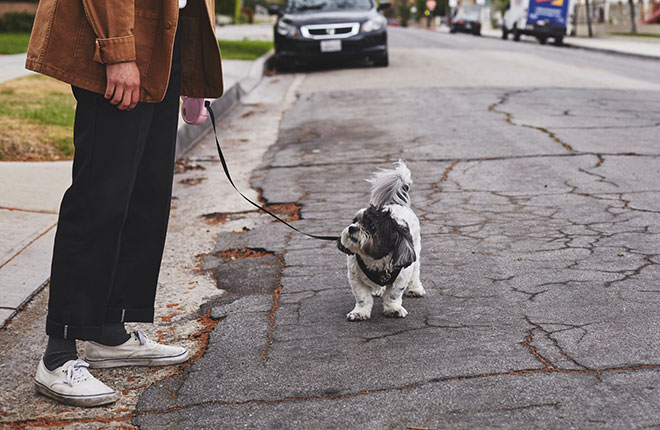Have you been noticing your dog slowing down on walks, or perhaps losing the pep in their step? It could be that your furry friend is showing signs of a common type of arthritis called osteoarthritis (OA). No matter how minor the signs may seem, they’re too important to ignore because these changes in their behavior can be an indication that your dog is in pain.
Signs Your Dog is Uncomfortable
Whether it’s trouble walking or jumping, struggling with stairs, or maybe less tail-wag greetings at the door – these could all signal OA pain. OA can affect one or more of your dog’s joints, and in addition to causing pain, can lead to stiffness, joint swelling and lameness. Not only can the pain make dogs less active and able, but it can also make them feel less themselves. That’s because the effects of OA pain can take a toll on how dogs function and as how they feel and behave.

No one knows your dog better than you, so we recommend filling out our short and simple OA quiz and share it with your veterinarian.
Any dog can get OA, and it can be easily missed or blamed on something like old age
How Common is Osteoarthritis?
More dogs suffer from OA pain than you might think. In a recent study of 504 dogs whose owners completed a checklist during a visit with a veterinarian, nearly 40% of dogs were diagnosed with OA pain.[1] You may be thinking, “Not my dog.” But, in fact, any dog can get OA, and it can be easily missed or blamed on something else, like old age. But OA doesn’t just come with old age—it affects dogs of all ages, sizes, and breeds.[2] And while there is no cure, being able to recognize the signs of OA pain and seeking proper treatment for your pup can help, not only ease the pain, but slow down OA progression and improve quality of life.
How To Control Osteoarthritis
While you might think to take treatment into your own hands with home remedies, its actually best left to the veterinarian. DIY remedies can often be dangerous if not cleared by a professional, so your best bet is speaking to your veterinarian about treatment. Even giving your dog a pain reliever that is meant for you or for another pet may be toxic for your dog with OA pain. So, if your dog’s showing signs of OA pain, it’s very important that you talk to your veterinarian right away to make an appointment and ask about an effective approach to pain management. There are two types of medications that are considered first-line treatment options for dogs with OA pain. Non-steroidal anti-inflammatory drugs (NSAIDs) and anti-nerve growth factor monoclonal antibodies (anti-NGF mAbs). NSAIDs are oral medications that are given at home once daily. Anti-NGF mAbs are injectable medications, given once monthly by a veterinary professional. A conversation with your veterinarian will help determine which medication is best for your dog.3 Ultimately, you want to have a medication that reduces pain and improves your dog's mobility and quality of life as well as being easy to administer.
Your veterinarian may also talk to you about the importance of other steps you can take to minimize your dog’s pain, such as weight control and exercise. Left untreated, the effects of OA can get worse. But with the proper treatment, and as long as you stick with the prescribed course, your veterinarian can help your dog start doing those activities that they have stopped doing because of their OA pain: A ball dropped at your feet, that excited greeting at the door, signs that your pet is more comfortable and acting like themselves again.
RIM-00252R2
IMPORTANT SAFETY INFORMATION: Librela is for use in dogs only. Women who are pregnant, trying to conceive or breastfeeding should take extreme care to avoid self-injection. Hypersensitivity reactions, including anaphylaxis, could potentially occur with self-injection. Librela should not be used in breeding, pregnant, or lactating dogs. Librela should not be administered to dogs with known hypersensitivity to bedinvetmab. Adverse events reported post-approval include ataxia (lack of balance/coordination), anorexia (loss of appetite), lethargy (tiredness), emesis (vomiting), and polydipsia (increased drinking). The most common adverse events reported in a clinical study were urinary tract infections, bacterial skin infections and dermatitis (skin irritation/inflammation). See full Prescribing Information.
See the Client Information Sheet for more information about Librela.
- Wright A., et al. Identification of canine osteoarthritis using an owner-reported questionnaire and treatment monitoring using functional mobility tests. Journal of Small Animal Practice (2022), 1–10 DOI: 10.1111/jsap.13500
- Anderson KL et al. Risk Factors for Canine Osteoarthritis and Its Predisposing Arthropathies: A Systematic Review. Front. Vet. Sci. 7:220. doi: 10.3389/fvets.2020.00220
- Reid, J., et al., Vet Comp Orthop Traumatol, 2018. Measuring chronic pain in osteoarthritic dogs treated long-term with carprofen, through its impact on health-related quality of life (HRQL).
- Gruen, M et. al. 2022 AAHA Pain Management Guidelines for Dogs and Cats. J Am Anim Hosp Assoc 2022; 58:55–76. DOI 10.5326/JAAHA-MS-7292
- Michels GM, et.al. A prospective, randomized, double-blind, placebo-controlled multisite, parallel-group field study in dogs with osteoarthritis conducted in the United States of America evaluating bedinvetmab, a canine anti-nerve growth factor monoclonal antibody. Vet Anaesth Analg. 2023;50(5):446-458. doi:10.1016/j.vaa.2023.06.003
- Corral MJ, et.al. A prospective, randomized, blinded, placebo-controlled multisite clinical study of bedinvetmab, a canine monoclonal antibody targeting nerve growth factor, in dogs with osteoarthritis. Vet Anaesth Analg. 2021;48:943-955. doi:10.1016/j.vaa.2021.08.001
- Brown DC, et.al. Development and psychometric testing of an instrument designed to measure chronic pain in dogs with osteoarthritis. Am J Vet Res. 2007;68(6):631-637. doi:10.2460/ajvr.68.6.631
- Brown DC, et.al. Ability of the Canine Brief Pain Inventory to detect response to treatment in dogs with osteoarthritis. J Am Vet Med Assoc. 2008;233(8):1278-1283. doi:10.2460/javma.233.8.1278




